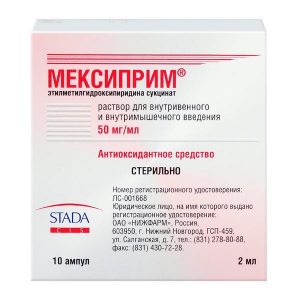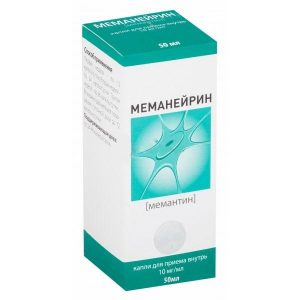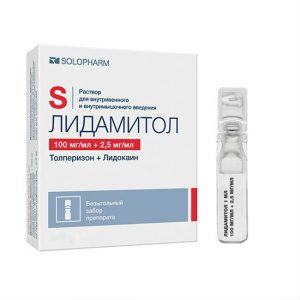Description
release form
Tablets
Packing
28 pcs
Pharmacological action of
The therapeutic effect of aripiprazole in schizophrenia is believed to be due to a combination of partial agonistic activity against D2-dopamine and 5HT1a-serotonin receptors and antagonistic activity against 5HT2a-serotonin receptors.
Aripiprazole has high in vitro affinity for D2 and D3 dopamine receptors, 5HT1a and 5HT2a serotonin receptors, and moderate affinity for D1 dopamine, 5HT2c and 5HT2 serotonin receptors, β 1 adrenoreceptors.
Aripiprazole is also characterized by moderate affinity for serotonin reuptake sites and a lack of affinity for muscarinic cholinergic receptors. Aripiprazole in experiments on animals showed antagonism in relation to dopaminergic hyperactivity and agonism in relation to dopaminergic hypoactivity. Some of the clinical effects of aripiprazole can be explained by interactions with receptors other than dopamine and serotonin.
Pharmacokinetics of
The average T1 / 2 of aripiprazole is approximately 75 hours. Css is reached after 14 days. Cumulation of the drug with repeated administration is predictable. The pharmacokinetics of aripiprazole in the equilibrium state of
are proportional to the dose. No diurnal fluctuations in the distribution of aripiprazole and its metabolite dehydroaripiprazole were noted. It was established that the main metabolite of the drug in human plasma, dehydroaripiprazole, has the same affinity for D2-dopamine receptors as aripiprazole.
Aripiprazole is rapidly absorbed after oral administration, while Cmax of aripiprazole in plasma is reached after 3-5 hours.
The oral bioavailability of Zilaxer is 87%. Eating does not affect the bioavailability of aripiprazole.
Aripiprazole is well distributed in tissues, with an apparent Vd of 4.9 L / kg, which indicates an intense extravascular distribution. At a therapeutic concentration of more than 99%, aripiprazole binds to serum proteins, mainly albumin.
Aripiprazole does not affect the pharmacokinetics and pharmacodynamics of warfarin, that is, it does not displace warfarin from its association with blood proteins.
Aripiprazole undergoes a presystemic metabolism only to a minimal extent. Aripiprazole is metabolized in the liver in three ways: dehydrogenation, hydroxylation and N-dealkylation. According to in vitro data, aripiprazole dehydrogenation and hydroxylation occurs under the action of the CYP3A4 and CYP2D6 isoenzymes, and N-dealkylation is catalyzed by the CYP3A4 isoenzyme.
At equilibrium, the AUC of dehydroaripiprazole is approximately 40% of the AUC of aripiprazole in the blood plasma.
After a single dose of labeled 14C-aripiprazole, approximately 27% and 60% of the radioactivity is determined in urine and feces, respectively. Less than 1% of unchanged aripiprazole is determined in the urine and approximately 18% of the dose taken is unchanged excreted through the intestines with bile. The total clearance of aripiprazole is 0.7 ml / min / kg, mainly due to excretion by the liver.
Indications
Schizophrenia: acute attacks and maintenance therapy
type 1 bipolar disorder: manic episodes and maintenance therapy to prevent relapse in patients with type I bipolar disorder who have recently had a manic or mixed episode.
Contraindications
hereditary galactosemia, lactase deficiency, glucose-galactose malabsorption
age up to 18 years (effectiveness and safety have not been established)
lactation period
hypersensitivity to aripiprazole or other components of the Zilaxer drug.
Caution: cardiovascular diseases (coronary heart disease or myocardial infarction, chronic heart failure or a history of conduction disturbances) cerebrovascular diseases of the state predisposing to the development of arterial hypotension (dehydration, hypovolemia, therapy with antihypertensive drugs) due to the possibility of developing orthostatic hypotension or arterial hypertension, including progressive or malignant hereditary syndrome of prolonged QT interval on ECG epilepsy, seizures, or diseases in which convulsions are possible, diabetes mellitus or the presence of risk factors for the development of diabetes mellitus (obesity, family history of diabetes mellitus) patients with an increased risk of aspiration pneumonia due to the risk of developing impaired motor function of the esophagus and aspiration elderly patients severe liver failure patients with a high risk of suicide (psychotic diseases, bipolar disorder), in persons aged 18-24 years, due to the risk of developing suicidal behavior, pregnancy, the risk of developing hyperthermia (intense physical stress shki, overheating, taking anticholinergics of drugs, dehydration).
Use during pregnancy and lactation
Adequate and well-controlled studies with aripiprazole in pregnant women have not been conducted. It is recommended that you inform your doctor about your pregnancy or its planning. Zilaxer can be taken during pregnancy if the potential benefit to the mother outweighs the potential risk to the fetus.
During treatment with Zilaxer, breastfeeding should be discontinued.
Composition
active substance: aripiprazole 15 mg
Dosage and administration
Inside, once a day, regardless of food intake.
Schizophrenia
Initial dose of 10-15 mg 1 time per day. The maintenance dose is 15 mg / day.
Clinical studies have shown drug efficacy in doses of 10 to 30 mg / day.
The maximum daily dose is 30 mg / day.
Manic episodes in bipolar disorder
Initial dose 15-30 mg / day.
If necessary, dose adjustment is carried out with an interval of at least 24 hours. Clinical studies have shown the effectiveness of the drug in doses of 15-30 mg / day for manic episodes when taken within 3-12 weeks. Safety doses above 30 mg / day have not been evaluated in clinical studies. When observing patients with type 1 bipolar disorder who underwent a manic or mixed episode, in which symptoms were stabilized while taking aripiprazole (15 mg / day or 30 mg / day) for 6 months and beyond, within 17 months, the beneficial effect of such supportive therapy has been established. Patients should be examined periodically to determine the need for continued maintenance therapy.
Renal failure and liver failure (Child-Pugh classification A and B) – dose adjustment is not required. Severe liver failure (Child-Pugh class C classification) – it is recommended to carefully select the dose of the drug and use with caution the maximum daily dose of 30 mg.
Experience with the drug in patients over 65 years of age is limited. Given the high susceptibility of this patient population and in the presence of disturbing clinical factors, treatment should be started with lower doses.
Side effects
Classification of the incidence of side effects: very often (> 1/10), often (from> 1/100 to <1/10), infrequently (from> 1/1000 to <1/100), rarely ( from> 1/10 000 to <1/1000), very rarely (from <1/10000, including individual messages). From the cardiovascular system: often – orthostatic hypotension, tachycardia infrequently – bradycardia, palpitations, myocardial infarction, prolonged QT interval, cardiac arrest, hemorrhage, atrial fibrillation, heart failure, AV block, myocardial ischemia, venom phlebitis, extrasystole, decreased blood pressure rarely – vasovagal syndrome, expansion of the borders of the heart, atrial flutter, thrombophlebitis, intracranial bleeding, cerebral ischemia is very rare – fainting. From the digestive system: very often – nausea, anorexia often – dryness of the nasal mucosa, dyspepsia, heaviness in the abdomen, vomiting, constipation infrequently – increased appetite, gastroenteritis, difficulty swallowing, flatulence, gastritis, dental caries, gingivitis, hemorrhoids gastroesophageal reflux, gastrointestinal hemorrhage, periodontal abscess, swelling of the tongue, fecal incontinence, colitis, rectal hemorrhage, stomatitis, ulceration of the oral mucosa, cholecystitis, fecal, candidiasis of the mucous membrane oral cavity, cholelithiasis, belching, gastric ulcer rarely – esophagitis, bleeding from the gums, glossitis, melena, intestinal bleeding, duodenal ulcer, cheilitis, hepatitis, liver enlargement, pancreatitis, intestinal perforation, bloody vomiting is very rare – increased activity of ALT and ACT, jaundice, dysphagia. On the part of the immune system: very rarely – allergic reactions: anaphylaxis, angioedema, laryngospasm, pruritus, urticaria. From the musculoskeletal system: often – muscle stiffness, myalgia, muscle cramps infrequently – ossalgia, arthralgia, myasthenia gravis, arthrosis, arthrosis, muscle weakness, muscle cramps, bursitis very rarely – increased creatine phosphokinase (CPK) activity, rhabdomyolysis, tendonitis, tenobursitis, rheumatoid arthritis, myopathy From the nervous system: very often – insomnia, drowsiness, akathisia often – dizziness, tremor, extrapyramidal syndrome, psychomotor agitation, depression, nervousness, increased salivation, hostility, suicide nye thoughts, mania, unsteady gait, confusion, resistance to performing passive movements (gear syndrome), sedation infrequently – dystonia, muscle twitching, decreased concentration, paresthesia, tremor of the extremities, impotence, bradykinesia, decreased / increased libido, panic reactions, apathy, dyskinesia, memory loss, stupor , amnesia, stroke, hyperactivity, depersonalization, myoclonus, depressed mood, hyperreflexia, slowing of mental function, hypersensitivity to irritants, oculomotor disturbance rare reactions – delirium, euphoria, buccogloss syndrome, akinesia, depression of consciousness up to loss of consciousness, hyporeflexia, obsessive thoughts, malignant antipsychotic syndrome is very rare – speech disorder. From the respiratory system: often – shortness of breath, pneumonia infrequently – bronchospasm, nosebleeds, hiccups, laryngitis rarely – hemoptysis, aspiration pneumonia, increased sputum production, dryness of the nasal mucosa, pulmonary edema, pulmonary embolism, hypoxia, respiratory failure, apnea. From the skin: often – dry skin, itching, excessive sweating, ulceration of the skin infrequently – acne, vesiculobullous rash, eczema, alopecia, psoriasis, seborrhea rarely – maculopapular rash, exfoliative dermatitis, urticaria. On the part of the sensory organs: often – conjunctivitis, ear pain infrequently – dry eyes, eye pain, tinnitus, middle ear inflammation, cataracts, taste loss, blepharitis rarely – increased lacrimation, frequent blinking, otitis externa, amblyopia, deafness , diplopia, intraocular hemorrhage, photophobia. From the genitourinary system: often – urinary incontinence infrequently – cystitis, frequent urination, leukorrhea, urinary retention, hematuria, dysuria, amenorrhea, premature ejaculation, vaginal bleeding, vaginal candidiasis, renal failure, uterine bleeding, menorrhagia, albuminuria, urine, urine – pain in the mammary gland, cervicitis, galactorrhea, anorgasmia, burning of the external genital organs, glucosuria, gynecomastia, nephrolithiasis, painful erection is very rare – priapism. From the side of metabolism: often – weight loss infrequently – dehydration, edema, hypercholesterolemia, hyperlipidemia hyperglycemia, hypokalemia, diabetes, thirst, high blood urea, hyponatremia, iron deficiency anemia, hypercreatininemia, hyperbilinemia, hyperbilinemia, increased activity of lactate dehydrogenase (LDH), obesity, increased activity of alkaline phosphatase (ALP) rarely – hyperkalemia, gout, hypernatremia, cyanosis, acidification of urine, hypoglycemia Other: often – flu-like syndrome, peripheral edema, chest pain – facial swelling, malaise, photosensitivity, pain in the jaw, chills, stiffness of the jaw, chest tension rarely – sore throat, stiffness in the back, heaviness in the head, candidiasis, stiffness in the throat, Mendelssohn syndrome, heat stroke. Drug Interaction No significant effect of histamine H2 receptor blocker famotidine causing potent inhibition of hydrochloric acid secretion in the stomach on the pharmacokinetics of aripiprazole was observed. There are various routes of aripiprazole metabolism, including the CYP2D6 and CYP3A4 isoenzymes. In studies in healthy humans, potent inhibitors of the CYP2D6 isoenzyme (quinidine) and CYP3A4 isoenzymes (ketoconazole) reduced aripiprazole clearance by 52% and 38%, respectively. Therefore, the dose of aripiprazole should be reduced when used in combination with CYP3A4 and CYP2D6 isoenzyme inhibitors. Taking 30 mg of aripiprazole with carbamazepine, a potent inducer of the CYP3A4 isoenzyme, was accompanied by a decrease of 68% and 73% of C max and AUC of aripiprazole, respectively, and a decrease of 69% and 71% of C max and AUC of its active metabolite, dehydro aripiprizole, respectively. The other potent inducers of CYP3A4 and CYP2D6 isoenzymes can be expected to be similar. In vitro metabolism of aripiprazole does not involve CYP1A1, CYP1A2, CYP2A6, CYP2B6, CYP2C8, CYP2C9, CYP2C19, and CYP2E1 isoenzymes, therefore its interaction with drugs and other factors is not likely to be induced (e.g. Co-administration of lithium or valproic acid with 30 mg of aripiprazole had no clinically relevant effect on the pharmacokinetics of aripiprazole. In clinical trials, aripiprazole at doses of 10-30 mg / d had a significant effect on the metabolism of CYP2D6 (dextromethorphan), CYP2C9 (warfarin), CYP2C19 (omeprazole, warfarin) and CYP3A4 (dextromethorphan) substrates. In addition, aripiprazole and its major metabolite, dehydroaripiprazole, did not alter metabolism involving the CYP1A2 isoenzyme in vitro. The clinically relevant effect of aripiprazole on the drugs metabolized by these enzymes is unlikely. Overdose Clinical studies have described cases of accidental or intentional overdose of aripiprazole with a single intake up to 1080 mg, which were not fatal. Symptoms: depression of consciousness of varying severity, up to coma, nausea, vomiting, asthenia, diarrhea, drowsiness. No clinically significant changes in major physiological parameters, laboratory parameters, and electrocardiogram (ECG) were detected in hospitalized patients. The post-marketing experience of single-dose admission of up to 450 mg of aripiprazole in adults indicates a possible development of tachycardia. In addition, cases of accidental ingestion of aripiprazole in children (up to 195 mg) have been described. Potentially dangerous overdose symptoms include extrapyramidal, convulsive, dystonic, cardiovascular (QT prolongation on ECG, atrial fibrillation) disorders, and transient loss of consciousness. Treatment: supportive therapy, ensuring adequate airway patency, oxygenation, effective lung ventilation and symptomatic treatment. Drug reactions should be considered. Monitoring of cardiac performance should be initiated immediately with ECG recording to detect arrhythmias. After a confirmed or suspected aripiprazole overdose, close medical follow-up is required until all symptoms have resolved. Activated charcoal (50 g), administered 1 h after aripiprazole administration, reduced aripiprazole AUC and Cmax by 51 and 41%, respectively, which suggests its use in overdose. Although there are no reliable data on the use of hemodialysis in the overdose of aripiprazole, a beneficial effect of this method is unlikely, since aripiprazole is practically not excreted by the kidneys in the unaltered form and is largely bound to plasma proteins. Storage conditions The drug is stored at a temperature not exceeding 30 ° C, in the original packaging. Keep out of the reach of children. Expiration 2 years. The active substance A ypyprazol Terms of delivery from pharmacies Prescription Dosage form Dosage form tablets KRKA d.d. New Town AO, Slovenia




